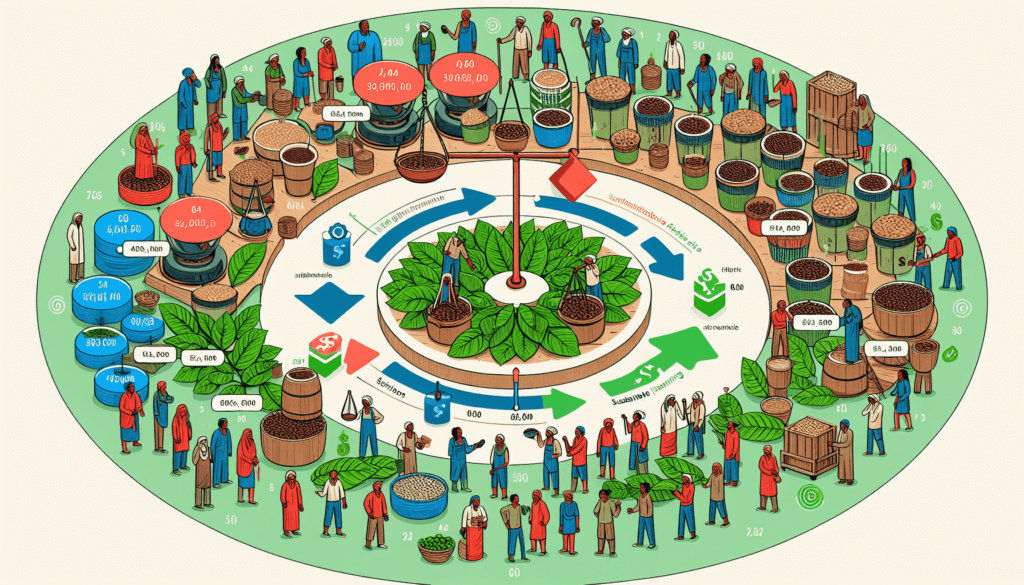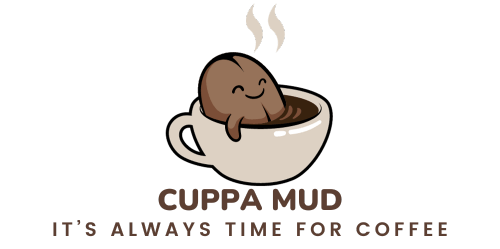Imagine being able to set the perfect price for your coffee products, ensuring profitability while also promoting sustainability. In this article, we will guide you on how to develop a coffee pricing strategy that not only considers your costs and competition but also takes into account the environmental and social impact of your business. By following these steps, you will be able to strike the ideal balance between profitability and sustainability, ensuring the long-term success of your coffee business. So, grab a cup of your favorite brew and let’s get started on building a pricing strategy that will take your coffee business to new heights.
Understanding the Coffee Industry
Researching the coffee market
To develop a successful coffee pricing strategy, it is crucial to conduct thorough research on the coffee market. This includes gathering information about current trends, consumer preferences, and market dynamics. By understanding the overall landscape, you can make informed decisions about your pricing strategy.
Analyzing the coffee production process
A key aspect of understanding the coffee industry is to delve into the production process. This involves studying how coffee beans are grown, harvested, processed, and roasted. By gaining insights into the intricacies of coffee production, you can better understand the costs involved and make pricing decisions accordingly.
Studying coffee supply and demand
Another important factor in understanding the coffee industry is to analyze the supply and demand dynamics. This involves studying factors like global coffee production, consumption trends, and market fluctuations. By keeping a close eye on supply and demand, you can identify potential price fluctuations and adjust your pricing strategy accordingly.
Identifying key players in the industry
Understanding the coffee industry also means recognizing the key players within it. This includes coffee producers, suppliers, roasters, distributors, and retailers. By studying the strategies and pricing models of successful coffee businesses, you can gain insights and inspiration to develop your own pricing strategy.
Factors Influencing Coffee Pricing
Cost of production
The cost of production is a fundamental factor influencing coffee pricing. It includes various expenses such as labor, equipment, raw materials, and overhead costs. By accurately calculating these costs, you can determine a baseline price for your coffee products.
Quality and grading of coffee beans
The quality and grading of coffee beans also play a significant role in pricing. Higher-quality beans often command a premium price due to their superior flavor profiles and uniqueness. Understanding the grading system and differentiating your coffee based on quality can allow you to set higher prices for specialty coffee offerings.
Market conditions and competition
The coffee pricing landscape is heavily influenced by market conditions and competition. Factors like the overall economic climate, existing market prices, and the presence of competitors can impact your pricing strategy. By keeping a close eye on these external factors, you can adjust your prices to remain competitive while maximizing profitability.
Sustainability initiatives
In recent years, sustainability has become increasingly important in the coffee industry. Consumers are willing to pay a premium for coffee produced in an environmentally and socially responsible manner. By implementing sustainable practices and certifications, you can justify higher prices and attract sustainability-conscious customers.
Consumer preferences
Understanding consumer preferences is crucial in determining the right pricing strategy. Some customers prioritize affordability, while others are willing to pay more for unique flavors, organic certifications, or fair trade practices. By segmenting your target market and aligning your pricing with their preferences, you can cater to different customer segments effectively.

Setting Profitability Goals
Determining desired profit margins
Before finalizing your pricing strategy, it is essential to determine your desired profit margins. Consider factors such as your business model, overhead expenses, and investment returns. This will provide you with a clear target and guide your pricing decisions.
Analyzing production costs and overhead expenses
To set profitability goals, you need to analyze your production costs and overhead expenses. This includes calculating labor costs, raw material expenses, rent, utilities, and any other expenses related to running your coffee business. By understanding your costs, you can set competitive prices while ensuring profitability.
Considering market trends and pricing benchmarks
Market trends and pricing benchmarks can provide valuable insights into the pricing landscape. Analyze how your competitors are pricing their products and identify any pricing trends within the industry. This information can help you make informed decisions about your own pricing strategy.
Evaluating pricing strategies of successful coffee businesses
Successful coffee businesses can provide valuable lessons and inspiration for your pricing strategy. Study how these businesses position themselves in the market and the pricing strategies they use to attract customers. By adapting proven strategies to fit your business model, you can increase your chances of profitability.
Sustainable Coffee Practices
Understanding the importance of sustainability
Sustainability is a crucial consideration in the coffee industry. By understanding the importance of sustainable practices, you can contribute to the long-term viability of your business and the industry as a whole. Sustainable coffee practices involve considering environmental, social, and economic factors throughout the supply chain.
Exploring sustainable cultivation methods
One aspect of sustainable coffee practices is exploring and implementing sustainable cultivation methods. This includes techniques such as shade-grown coffee, organic farming practices, and soil conservation. By adopting these methods, you can reduce the environmental impact of coffee production and attract environmentally conscious consumers.
Promoting fair trade and ethical sourcing
Promoting fair trade and ethical sourcing is essential for sustaining the livelihoods of coffee farmers and workers. This includes ensuring fair wages, safe working conditions, and equitable trade relationships. By supporting these practices and highlighting them to consumers, you can enhance your brand image and differentiate yourself in the market.
Implementing environmentally friendly practices
In addition to sustainable cultivation methods, implementing environmentally friendly practices throughout your coffee business is crucial. This can involve using energy-efficient equipment, reducing waste through recycling and composting, and minimizing water consumption. By reducing your ecological footprint, you can contribute to a more sustainable coffee industry.

Calculating Cost of Production
Identifying direct and indirect costs
Calculating the cost of production requires identifying both direct and indirect costs. Direct costs include factors directly related to producing a cup or bag of coffee, such as the cost of beans and labor. Indirect costs encompass other expenses like rent, utilities, and equipment maintenance. Accurately accounting for both types of costs is essential for determining the overall cost of production.
Accounting for labor, materials, and equipment
Labor, materials, and equipment are vital components of the cost of production. Labor costs include wages for coffee farmers, roasters, and baristas. Materials encompass coffee beans, packaging, and any other items necessary for production. Equipment costs include the purchase or lease costs of roasters, grinders, and brewing equipment.
Including overhead expenses
Overhead expenses comprise costs not directly tied to the production process but necessary for running the business. This can include rent, utilities, insurance, marketing expenses, and administrative costs. These expenses need to be factored into the cost of production to ensure accurate pricing.
Calculating variable and fixed costs
Variable costs vary according to the level of production, while fixed costs remain constant regardless of production levels. Variable costs may include labor and materials, while fixed costs encompass overhead expenses like rent and insurance. Calculating these costs accurately will enable you to determine a comprehensive cost of production and make informed pricing decisions.
Pricing Strategies for Different Market Segments
Determining target customer segments
To develop effective pricing strategies, it is crucial to identify and understand your target customer segments. Different customer groups may have varying preferences, budgets, and price sensitivity. By segmenting your market and tailoring your prices accordingly, you can maximize revenue and attract a diverse range of customers.
Analyzing price elasticity of demand
Understanding price elasticity of demand is essential for choosing the right pricing strategies. Price elasticity refers to how sensitive customers are to changes in price. Elastic demand means customers are highly sensitive to price changes, while inelastic demand means customers are less influenced by price. By analyzing the price elasticity of your product, you can determine appropriate pricing strategies.
Implementing premium pricing for specialty coffee
If you offer specialty or high-quality coffee, implementing premium pricing can be a successful strategy. Customers who seek unique flavors or are willing to pay more for exceptional quality are often willing to pay higher prices. By positioning your specialty coffee as a premium product, you can attract customers and differentiate yourself in the market.
Offering competitive prices for the mainstream market
For customers who prioritize affordability, offering competitive prices is crucial. Analyze market prices and find the appropriate balance between profitability and competitiveness. By offering fair prices without sacrificing quality, you can attract price-sensitive customers and build a strong customer base.

Implementing Pricing Structures
Examining pricing models: cost-plus, value-based, etc.
When implementing pricing structures, it is essential to consider different pricing models. Common models include cost-plus pricing, value-based pricing, penetration pricing, and skimming pricing. Each model has its own advantages and considerations. By examining these models and choosing the best fit for your business, you can create effective pricing structures.
Creating tiered pricing structures
Creating tiered pricing structures can cater to customers with different preferences and budget constraints. By offering multiple options, such as different sizes or packaging, you can provide customers with choices while maximizing revenue. Tiered pricing structures also enable you to balance the perceived value with the costs of production.
Incorporating discounts and promotions
Incorporating discounts and promotions can be an effective strategy to attract new customers and encourage repeat business. Consider offering promotional pricing for limited periods, bundling products, or providing loyalty discounts. By strategically implementing discounts and promotions, you can drive sales while maintaining profitability.
Introducing subscription or loyalty programs
Subscription or loyalty programs can offer customers convenience and incentives to choose your coffee over competitors. By offering discounted prices, exclusive access to new products, or personalized recommendations, you can build customer loyalty and foster long-term relationships. These programs can also provide a steady revenue stream and improve customer retention.
Monitoring and Adjusting Pricing
Tracking sales performance and customer feedback
To ensure the effectiveness of your pricing strategy, it is essential to track sales performance and gather customer feedback. Analyze sales data to identify patterns, trends, and customer behavior. Collect feedback through surveys, social media, or direct customer interactions to understand how your pricing strategy is perceived and make necessary adjustments.
Analyzing market trends and competitor prices
Market trends and competitor prices can provide valuable insights for adjusting your pricing. Analyze how your competitors are pricing their products and identify any changes in market conditions. By staying up-to-date with the industry, you can make informed decisions and remain competitive.
Evaluating the impact of pricing changes
When implementing pricing changes, it is crucial to evaluate their impact on your business. Monitor the changes in sales volume, profit margins, and customer satisfaction. Assess whether the changes align with your profitability goals and if they have the desired effect on your business. Based on the data, make adjustments as necessary to optimize your pricing strategy.
Making data-driven adjustments as needed
To continuously optimize your pricing strategy, it is important to make data-driven adjustments. Regularly review sales data, customer feedback, and market trends to identify areas for improvement. By using data as a guide, you can make informed decisions and adapt your pricing strategy to changing market conditions.

Building Brand Value and Differentiation
Investing in brand development and marketing
Building brand value and differentiation requires investing in brand development and marketing efforts. Develop a strong brand identity, including a compelling brand story, logo, and visual elements. Create marketing campaigns that highlight your unique selling points, values, and the benefits of choosing your coffee. By effectively communicating your brand, you can attract customers and stand out in the competitive coffee market.
Highlighting unique selling points
To differentiate your coffee business, it is crucial to highlight your unique selling points. Identify what sets your coffee apart, whether it’s the flavor profile, origin, sustainability practices, or customer experience. Emphasize these unique elements in your marketing materials and communication channels to attract customers who resonate with these qualities.
Creating a memorable customer experience
Providing a memorable customer experience is key to building brand value and differentiation. Ensure that every interaction a customer has with your business is positive and memorable, from the moment they enter your coffee shop to the last sip of their beverage. Train your staff to deliver exceptional customer service, create a welcoming ambiance, and offer personalized recommendations. By exceeding customer expectations, you can cultivate customer loyalty and encourage word-of-mouth referrals.
Building customer loyalty and trust
Building customer loyalty and trust is essential for long-term success. Offer loyalty programs, incentives, and personalized experiences to reward repeat customers. Communicate your commitment to quality, sustainability, and customer satisfaction consistently. By fostering trust and loyalty, you can increase customer retention and build a strong customer base.
Continuous Evaluation and Improvement
Regularly reviewing pricing strategy effectiveness
To ensure a sustainable and profitable coffee pricing strategy, it is crucial to regularly review its effectiveness. Monitor key performance indicators, sales data, and customer feedback to assess how well your pricing strategy aligns with your profitability and sustainability goals. Regular reviews will allow you to identify areas for improvement and make necessary adjustments.
Seeking feedback from employees and customers
To gain valuable insights and improve your pricing strategy, seek feedback from both employees and customers. Talk to your baristas and staff members who interact directly with customers, as they can provide valuable insights into customer preferences and pricing concerns. Additionally, take customer feedback seriously, whether it’s through surveys, online reviews, or face-to-face conversations. By listening to the opinions of those involved in your business, you can refine your pricing strategy.
Proactively adapting to changing market conditions
The coffee industry is dynamic, and market conditions can change rapidly. It is crucial to proactively adapt your pricing strategy to these changes. Stay informed about industry trends, consumer preferences, and market dynamics. Be ready to tweak your prices, promotions, and positioning to maximize profitability and remain relevant.
Continuously optimizing profitability and sustainability
Continuously optimizing both profitability and sustainability is essential for long-term success in the coffee industry. Regularly analyze your pricing strategy, production costs, and overhead expenses to find opportunities for improvement. Seek ways to enhance profitability while maintaining sustainable practices. By striving for the right balance, you can ensure the growth and sustainability of your coffee business.



